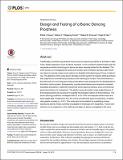Design and Testing of a Bionic Dancing Prosthesis
Author(s)
Rouse, Elliott J.; Villagaray-Carski, Nathan C.; Emerson, Robert W.; Herr, Hugh M
DownloadRouse-2015-Design and Testing o.pdf (400.0Kb)
PUBLISHER_CC
Publisher with Creative Commons License
Creative Commons Attribution
Terms of use
Metadata
Show full item recordAbstract
Traditionally, prosthetic leg research has focused on improving mobility for activities of daily living. Artistic expression such as dance, however, is not a common research topic and consequently prosthetic technology for dance has been severely limited for the disabled. This work focuses on investigating the ankle joint kinetics and kinematics during a Latin-American dance to provide unique motor options for disabled individuals beyond those of daily living. The objective of this study was to develop a control system for a bionic ankle prosthesis that outperforms conventional prostheses when dancing the rumba. The biomechanics of the ankle joint of a non-amputee, professional dancer were acquired for the development of the bionic control system. Subsequently, a professional dancer who received a traumatic transtibial amputation in April 2013 tested the bionic dance prosthesis and a conventional, passive prosthesis for comparison. The ability to provide similar torque-angle behavior of the biological ankle was assessed to quantify the biological realism of the prostheses. The bionic dancing prosthesis overlapped with 37 ± 6% of the non-amputee ankle torque and ankle angle data, compared to 26 ± 2% for the conventional, passive prosthesis, a statistically greater overlap (p = 0.01). This study lays the foundation for quantifying unique, expressive activity modes currently unavailable to individuals with disabilities. Future work will focus on an expansion of the methods and types of dance investigated in this work.
Date issued
2015-08Department
Massachusetts Institute of Technology. Department of Electrical Engineering and Computer Science; Massachusetts Institute of Technology. Media Laboratory; Program in Media Arts and Sciences (Massachusetts Institute of Technology)Journal
PLOS ONE
Publisher
Public Library of Science
Citation
Rouse, Elliott J., Nathan C. Villagaray-Carski, Robert W. Emerson, and Hugh M. Herr. “Design and Testing of a Bionic Dancing Prosthesis.” Edited by Lei Ren. PLoS ONE 10, no. 8 (August 18, 2015): e0135148.
Version: Final published version
ISSN
1932-6203